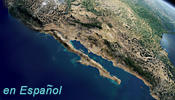![[Ocean Oasis Field Guide]](images/bnr-oo-field.gif)

![[Ocean Oasis Field Guide]](images/bnr-oo-field.gif) |  |
|
Avicennia germinans AVICENNIACEAE (Black Mangrove Family) This species is sometimes placed into the Verbenaceae (Vervain Family) by some taxonomists. Description
Despite its name, this is the lightest in color of the mangroves. Black Mangrove has opposite leaves, pale gray-green, shiny above, and often found encrusted with salt. The leaves are larger than most mangroves at 4.5 to 15 centimeters (2 to 6 inches) long and are oblong to lanceolate in shape. The tree grows to 8 meters (24 feet) high. The flowers are small — 0.2 centimeters (1/8th of an inch) —, white to yellow in color, and bloom from November to May. The fruit is about 1 centimeter (0.5 inch) in length and irregularly oblique shaped. Range and HabitatThis species can grow with Red Mangrove and Sweet Mangrove from Bahía de los Angeles and San Ignacio Lagoon, south along the Pacific and Gulf. Natural HistoryBlack Mangrove is one of the few mangroves that doesn't grow on stilt roots. The root system consists of long underground cable roots that produce hundreds of thin, upright pneumatophores in the water around the tree. These structures have numerous pores that are thought to conduct oxygen to the underground portions of the root system. |
Text by Bob Lauri and Judy Gibson
Black Mangrove leaves and flowers — photo by Jon Rebman
Mangroves
Field Guide |
Site Index |
Ocean Oasis Introduction
|
|
© 2000 San Diego Natural History Museum |